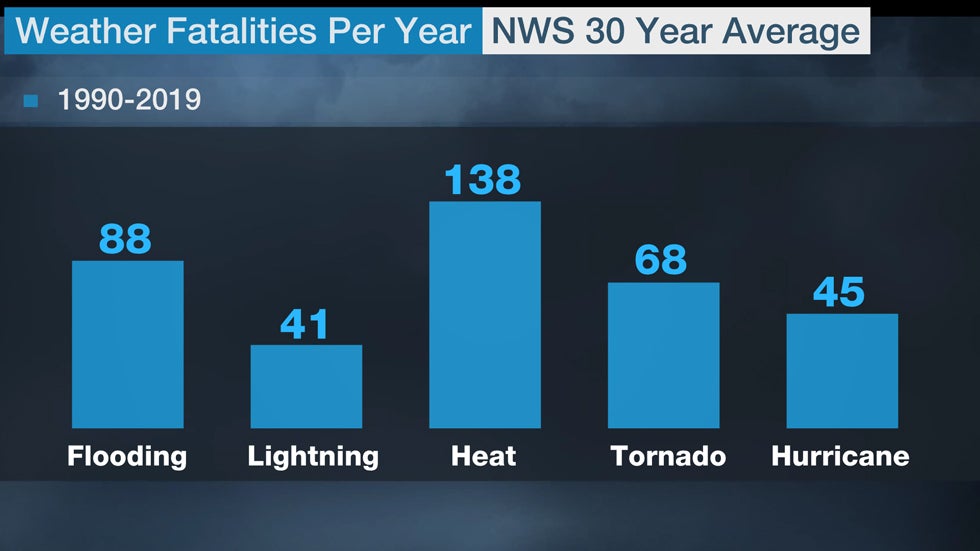Chris Dolce
Flooding has turned deadly in Louisiana this week, a reminder that this danger should be taken just as seriously as tornadoes and hurricanes, even though it doesn't typically garner as much attention.
An average of 88 people have been killed by flooding annually in the United States, according to 30-year statistics from NOAA (1990-2019). That's more than the average number of deaths per year from tornadoes (68) and hurricanes (45) during that time.
Only heat claims more lives in an average year than flooding.

We are in a time of year when it's especially important to be aware of a potential flood threat in your area.
(MORE: It's Prime Time For Flash Flooding in the U.S.)
Heavy rain is common in late spring and summer, given that warm, humid air is more abundant. That means thunderstorms can drop multi-inch rainfall totals in a short amount of time, especially when they persist over one area.
The threat of flooding from heavy rain and thunderstorms can exist in the South, Midwest and Northeast this time of year. It also expands into the Southwest once the summertime monsoon begins later in summer.
Tropical depressions, tropical storms and hurricanes can pile onto the flood danger when they strike.

Flooding this year had already killed 12 people in the U.S. through mid-May, according to statistics compiled by the National Weather Service in La Crosse, Wisconsin. Several of those happened when flash flooding hit Tennessee in March.
The toll has climbed higher this week, with flooding playing a role in at least two deaths in Louisiana as of Tuesday.
During the past 10 years, flooding deaths have ranged from a low of 29 in 2012 to highs of 189 and 180 in 2015 and 2017, respectively. The relatively low toll in 2012 was partly due to the U.S. having an expansive drought and its 15th-driest year on record.

One important takeaway – it's possible that a number of these flooding deaths could have been avoided. That's because 58% of the 997 fatalities blamed on flooding from 2011 to 2020 happened while driving, according to the NWS.
The worst decision you can make in a flash flood is driving your vehicle into floodwaters of unknown depth. It's always best to turn around and find another route or delay your trip, even if it disrupts important plans.
It's easy to misjudge the depth of flood water, particularly at night. Sometimes the bridge or road masked by floodwaters may have been undermined or completely washed out.
In some cases, the flash-flood event occurs over such a localized area, say one part of one county or city, that driving conditions may go from dry roads to high water in a matter of a few miles or within minutes.
Not convinced yet? Here are some facts from FEMA to consider:
- Six inches of water will reach the bottom of most passenger cars, causing loss of control and potential stalling.
- One foot of water will float many vehicles.
- Two feet of rushing water will carry away most vehicles, including SUVs and pickups.
Once your vehicle is floating, the floodwaters become your steering wheel. If that water is moving, your vehicle could be swept away, tipped on its side or flipped. Rising water can enter your vehicle in a manner of minutes, even seconds.
The bottom line is: "Turn around, don't drown," as the National Weather Service has campaigned for years.
The Weather Company’s primary journalistic mission is to report on breaking weather news, the environment and the importance of science to our lives. This story does not necessarily represent the position of our parent company, IBM.
The Weather Company’s primary journalistic mission is to report on breaking weather news, the environment and the importance of science to our lives. This story does not necessarily represent the position of our parent company, IBM.

No comments:
Post a Comment